MARIANI’SVirtual Gourmet
July
22, 2012
NEWSLETTER

THIS WEEK
The
Resort at Pelican Hill:
Festa Dell’Autunno
NEW YORK CORNER
Noise
Levels Reach Dangerous Highs
by John
Mariani
NOTES
FROM THE WINE CELLAR
The World’s Most
Endangered Wine Region:
Portugal’s Colares Appellation
❖❖❖
The Resort at Pelican Hill
Festa Dell’Autunno
By
Carey Sweet
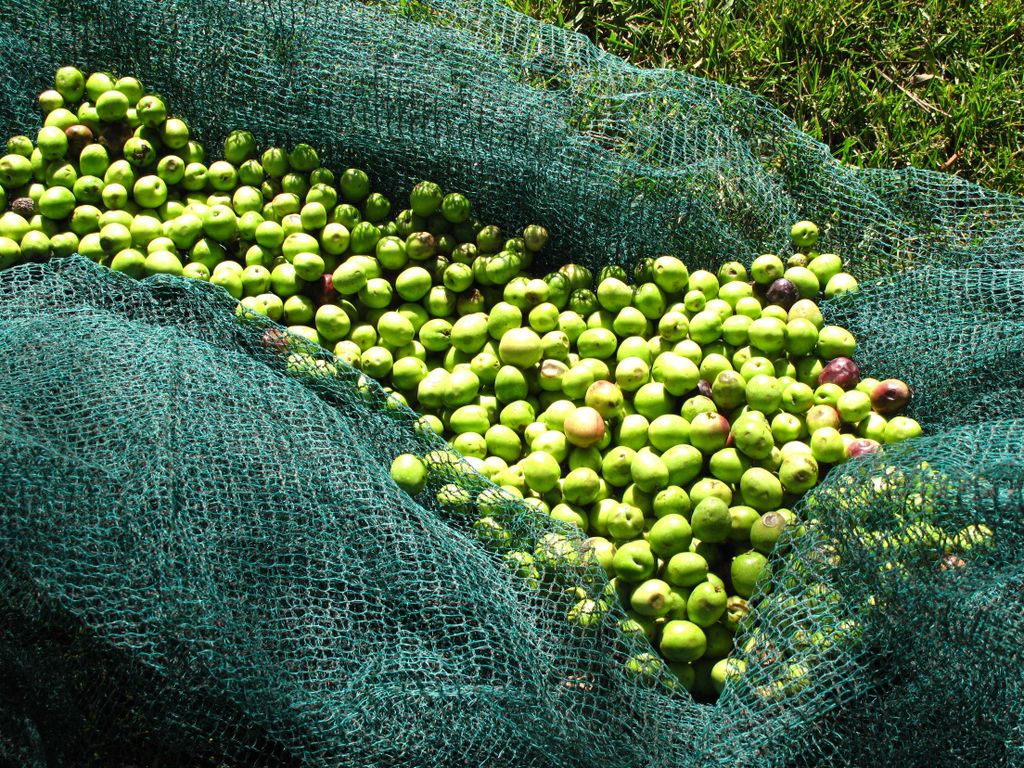
One of the challenges of growing
olives is that they are an alternate bearing fruit,
meaning that one year a tree may produce a plentiful
harvest, but the next year, the branches may be nearly
naked, which can make planning an annual olive
festival a bit tricky, as the organizers of the first
ever Festa Dell’Autunno at The Resort at Pelican Hill
(below) in Newport Beach, CA,
discovered last fall. As the day of the headliner
celebration grew near last October 29, there were few
olives to be had. The 504-acre property’s 750-plus
trees, imported as mature specimens up to 100 years
old when they were planted for the resort’s opening in
2008, hid just handfuls of the tangy orbs amid their
gray-green leaves.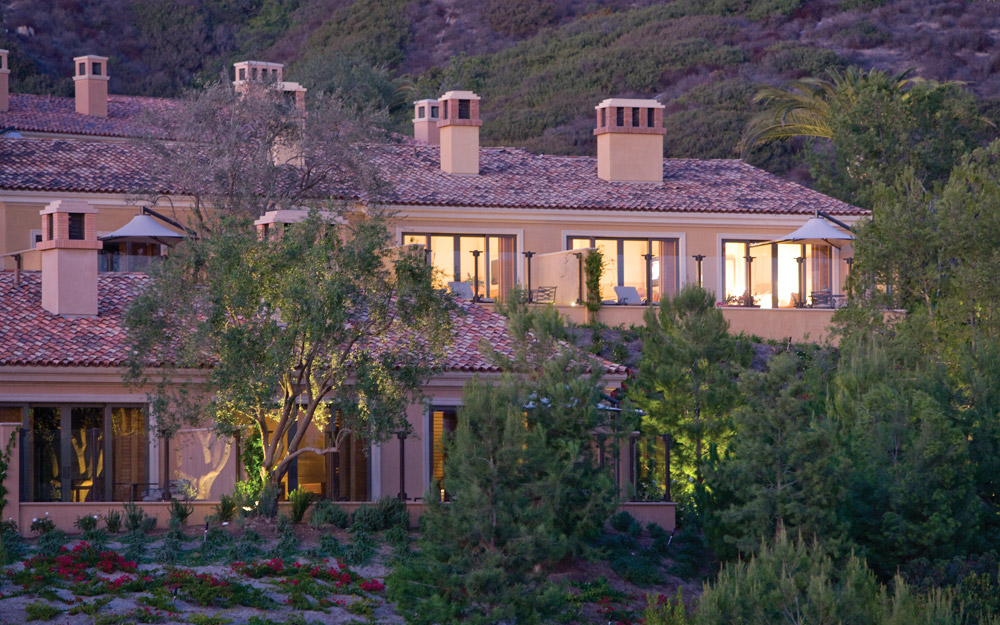
Yet no matter, for what might have been viewed as a
test-run of the salute to fruit was embraced by guests
anyway. Dozens made reservations at the resort to take
in a full day of olive-y celebrations, drawn by
attractions including demonstrations on olive pressing
from a local olive master using southern California
olives, food, wine, and music. Through November,
special olive oil tasting menus were offered at the
resort restaurants, tempting with dishes ranging from
olive oil poached Alaskan king salmon to baked apple
tart with olive oil gelato, while olive oil could also
be applied directly to the skin, in specialized
treatments at the resort spa.
While it’s summer now,
the next olive festival is not far off, and its
popularity means you might think of planning
ahead. Pelican Hill’s olive curator is already
working amid the trees for Festa Dell’Autunno MMXII,
surely whispering sweet nothings to the trees to
encourage the fruit to emerge. Tickets are on sale for
the 2012 party, which will take place November 2
through 4.
Already, the menus have been set by Pelican Hill’s
chefs, who will feature rustic olive oil in special
meals throughout the festival.
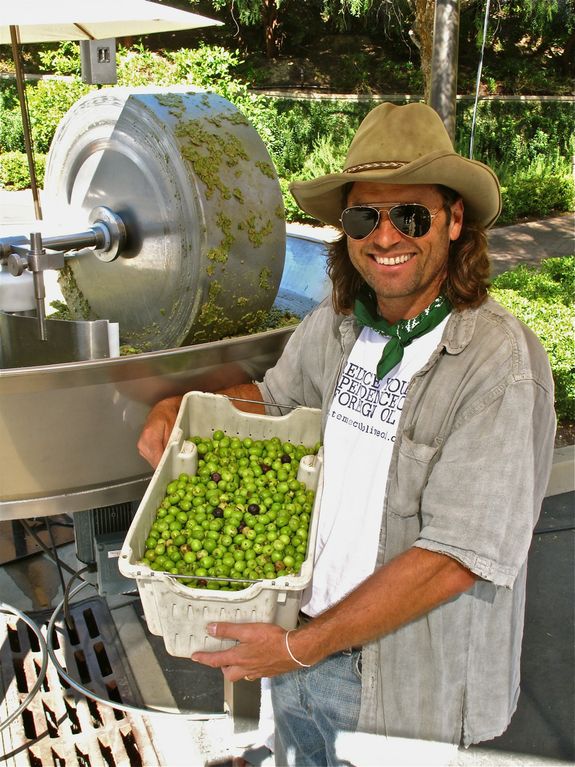 If sales of
Pelican Hill’s olive products are any indication of
consumer interest, this year’s Festival might play to
capacity crowds. The resort has bottled a private
label extra virgin oil, and for the first time this
year, batches are being sold in Resort’s boutique.
Harvests being what they are, the new oil is actually
in partnership with the nearby Temecula Olive Oil
Company, along with new olive oil soaps in orange
blossom, lavender and lemon verbena varieties.
If sales of
Pelican Hill’s olive products are any indication of
consumer interest, this year’s Festival might play to
capacity crowds. The resort has bottled a private
label extra virgin oil, and for the first time this
year, batches are being sold in Resort’s boutique.
Harvests being what they are, the new oil is actually
in partnership with the nearby Temecula Olive Oil
Company, along with new olive oil soaps in orange
blossom, lavender and lemon verbena varieties.
Seeing the pressing action at the festival last year
gave oil lovers like me a taste of how demanding the
process can be and how much fruit can be required to
extract the silky stuff. Olive master Thom Curry (left),
owner of Temecula Olive Oil Company, put on a live
pressing, filtering the golden-green liquid from
bushels of green fruit via a complicated machine that
looked like a giant metal wheel in a box stuck with
hoses. We could taste oil right from the press and in
different stages of aging (it’s meant to be consumed
young), 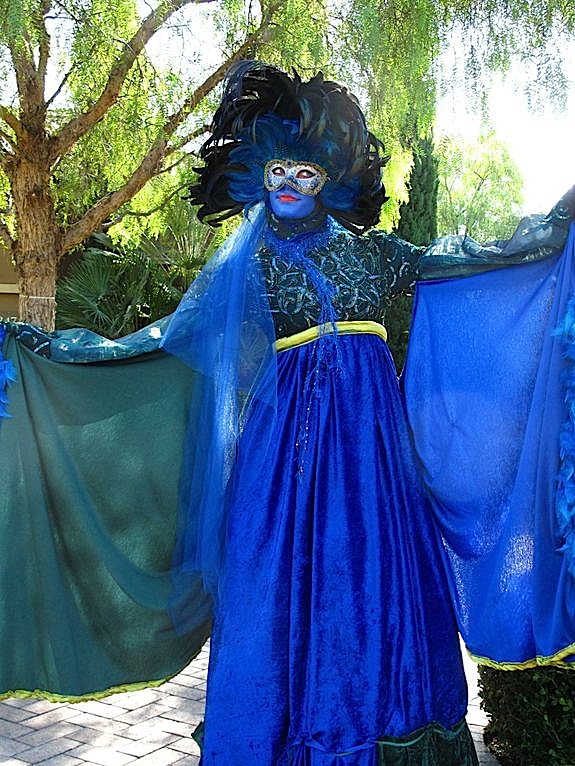 and to cleanse our palates, we
sipped wines, ate cheeses, pizzas, pastas and gelato,
then relaxed with espressos as accordion players and
live opera singers performed on a private, olive
tree-lined street fronting Pelican’s Tuscan style
guest bungalows.
and to cleanse our palates, we
sipped wines, ate cheeses, pizzas, pastas and gelato,
then relaxed with espressos as accordion players and
live opera singers performed on a private, olive
tree-lined street fronting Pelican’s Tuscan style
guest bungalows.
If there is a Goddess of Olive Oil (right), she
was there, though she did not speak, parading silently
through the crowds in head-to-toe royal blue, from her
face paint to her elaborate empire dress with its
train trailing regally behind her, her flowing cape
and towering feather headdress above her gold trimmed
eye mask.
I don’t know if Italians – or olive growers – spend
much time drawing with chalk on sidewalks either (below),
but the Southern California street painting artists
showcasing their works added a distinct festival
charm, working on their creations throughout the
daylong event, until the works appeared in full dusty
splendor: a lovely young peasant woman plucking
olives, another beauty posing proudly with a full
basket of fruit, and more. And for that bit of
extra something, we could sit inside a shiny new
Lamborghini, Maserati, Ferrari and several kicky
little Fiats on display.
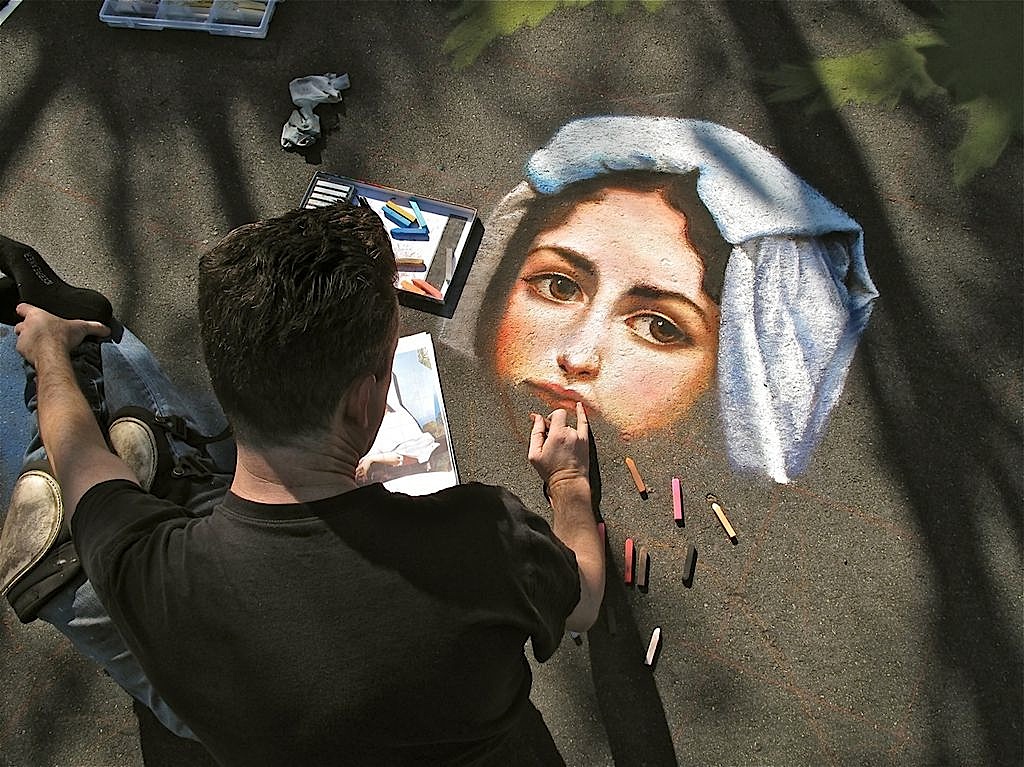 Certainly
the proper way to take in such an olive festival is to
spend the entire weekend at Pelican Hill. Just 15
minutes from Orange County’s John Wayne airport, the
property is a true showpiece even in a part of
California well known for its opulence. It might be
worth a visit simply to see the swimming pool, called
The Coliseum for its immense size of 136 feet spanning
a perfect circle with tiered decks and luxury cabanas
atop a hillside peeking down to the ocean. Somehow,
the resort’s owners, the Irvine Company, found
craftsmen willing to hand cut and lay more than a
million 1.5-inch square glass tiles to line the pool;
the effect is dazzling, like a bejeweled
Certainly
the proper way to take in such an olive festival is to
spend the entire weekend at Pelican Hill. Just 15
minutes from Orange County’s John Wayne airport, the
property is a true showpiece even in a part of
California well known for its opulence. It might be
worth a visit simply to see the swimming pool, called
The Coliseum for its immense size of 136 feet spanning
a perfect circle with tiered decks and luxury cabanas
atop a hillside peeking down to the ocean. Somehow,
the resort’s owners, the Irvine Company, found
craftsmen willing to hand cut and lay more than a
million 1.5-inch square glass tiles to line the pool;
the effect is dazzling, like a bejeweled 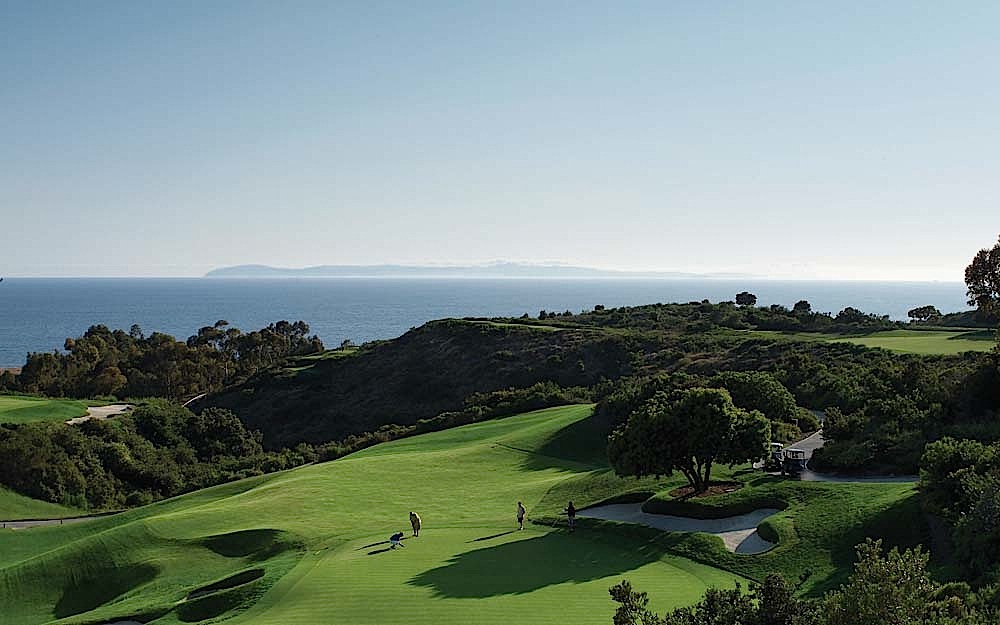 Roman amphitheater sparkling in
the sun and glittering against the evening lights.
There are two championship golf courses designed by
Tom Fazio (right), with ocean views from nearly
every hole, and when I wanted to get to that ocean
itself, a private shuttle was dispatched to my
bungalow doorstep, to deposit me at Crystal Cove State
Park for surfing, boating, fishing and whatever other
water wonders I craved.
Roman amphitheater sparkling in
the sun and glittering against the evening lights.
There are two championship golf courses designed by
Tom Fazio (right), with ocean views from nearly
every hole, and when I wanted to get to that ocean
itself, a private shuttle was dispatched to my
bungalow doorstep, to deposit me at Crystal Cove State
Park for surfing, boating, fishing and whatever other
water wonders I craved.
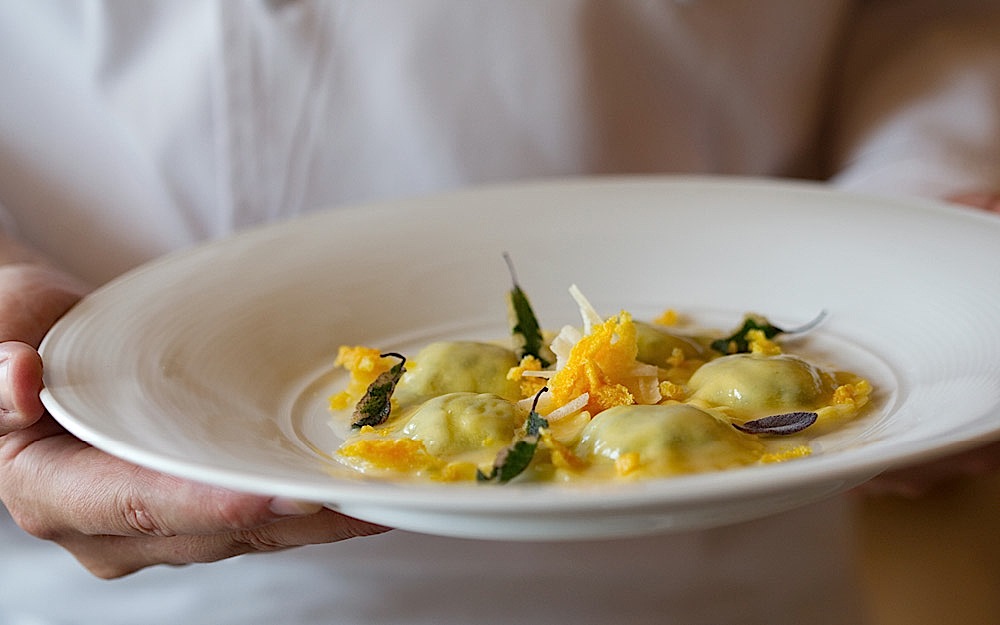 Everyone, meanwhile, can
appreciate the sumptuous flavors of an olive-themed
meal at the Northern Italian Andrea, which is so-named
in honor of Italian Renaissance architect Andrea
Palladio, whose work inspired the design of Pelican
Hill. Festival dinners are open to the general public,
and a preview menu for this fall promises delights
like monkfish carpaccio, lobster panzrotti (left),
and olive oil poached walu.
Everyone, meanwhile, can
appreciate the sumptuous flavors of an olive-themed
meal at the Northern Italian Andrea, which is so-named
in honor of Italian Renaissance architect Andrea
Palladio, whose work inspired the design of Pelican
Hill. Festival dinners are open to the general public,
and a preview menu for this fall promises delights
like monkfish carpaccio, lobster panzrotti (left),
and olive oil poached walu.
For a Festa spa treatment (below), I chose the
grape seed and olive oil scrub, but not until I had
relaxed in the meditation room for a good hour
beforehand, enjoying a spa lunch of crispy flatbread
painted with 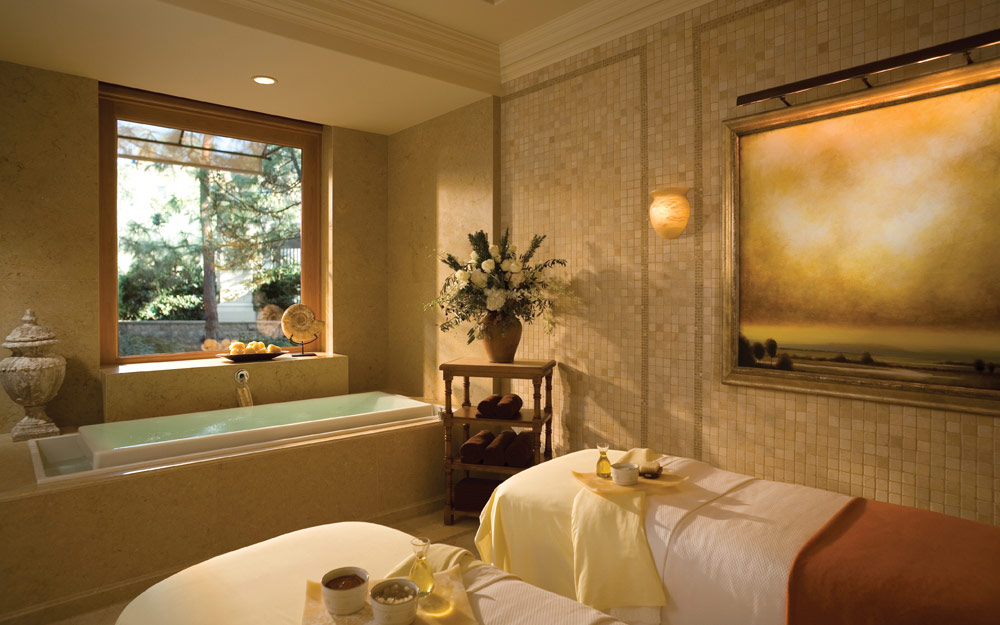 white bean puree and
scattered-in wild mushroom, roasted piquillo peppers
and baby arugula. For an extra nod to health, I sipped
an herbal tonic sparkling with mint leaves, rosemary,
cucumber, lemon, tonic and soda, then followed with a
“dessert” of a cherry tofu smoothie, swayed by my spa
therapist's insistence that cherries are high in
antioxidants, minerals and potassium, while tofu is
high in protein, calcium and vitamin E. If I had any
doubts about all this fuss about olives, the spa made
me a believer. First, I luxuriated in a warm, gentle
scrub of ground olive skins, grape seeds and olive
oil. Then, I melted into a deep massage, the therapist
slathering me with grape seed and olive oil lotions.
Through the evening and well into the next day, my
skin glowed and felt like satin. Inside and out, I
felt extravagantly nourished, and, yes, grateful that
it had still turned out to be a good year for olives.
white bean puree and
scattered-in wild mushroom, roasted piquillo peppers
and baby arugula. For an extra nod to health, I sipped
an herbal tonic sparkling with mint leaves, rosemary,
cucumber, lemon, tonic and soda, then followed with a
“dessert” of a cherry tofu smoothie, swayed by my spa
therapist's insistence that cherries are high in
antioxidants, minerals and potassium, while tofu is
high in protein, calcium and vitamin E. If I had any
doubts about all this fuss about olives, the spa made
me a believer. First, I luxuriated in a warm, gentle
scrub of ground olive skins, grape seeds and olive
oil. Then, I melted into a deep massage, the therapist
slathering me with grape seed and olive oil lotions.
Through the evening and well into the next day, my
skin glowed and felt like satin. Inside and out, I
felt extravagantly nourished, and, yes, grateful that
it had still turned out to be a good year for olives.
If
you go:
Festa Dell’Autunno Weekend Package 2012:
❖❖❖
NEW YORK CORNER
 Noise
Levels Reach Dangerous Highs
Noise
Levels Reach Dangerous Highs
by
John Mariani
BOOM-BADDA-BOOM The trouble with having music BOOM-BADDA-BOOM in restaurants these days BOOM-BADDA-BOOM
is that you can’t even BOOM-BADDA-BOOM
hear the music if you wanted to BOOM-BADDA-BOOM. Hold on, lemme turn it off. BADDA-BOOM!!!
O.K. That’s better. As I was
saying, the trouble with music in restaurants is that
they play the stuff so damn loud that it creates two
stultifying and nullifying phenomena: First, it causes
people to talk louder and louder to be heard, which in
turn blocks out any possibility of hearing anything
but the bass-and-drum line of the music--BOOM-BADDA-BOOM
BOOM-BADDA-BOOM
BOOM-BADDA-BOOM BOOM-BADDA-BOOM !!!!!
"Mood music" in
restaurants used to be of three kinds: New Age
guitar crap with titles like “Aspen at Twilight,”
Techno music with names like “Eine kleine
Schmetterlings-Hommage,” or classical strings, more often
than not Vivaldi’s “Four Seasons.” For a couple of
years there you couldn’t eat dinner without having to
listen to Andrea Bocelli and Sarah Brightman belting
out "Time to Say Goodbye." Ottmar Libert, Kenny G, The
Gypsy Kings, and Nora Jonesall had their day.
But that's changed in favor of restaurant owners and
chefs' playlists,
boomed in out of sheer ego.
The agony of sitting near a $50,000
speaker system and trying to enjoy one's monkfish with
fennel sauce can be unbearable at times, ruining an
otherwise delightful evening. One can hardly be
a sophisticated gastronome while the drums-and-bass of
a 50 Cent Jackson rap pounds in your ears.
What's worse, many restaurateurs pump up the sound as
their customers elevate their own voices in order to
be heard. They call this "maintaining the
energy," terrified that there might be a millisecond
of silence
in a room full of 150 guests shouting
across the table from each other.
Now
comes a NY Times article entitled "Working
or Playing Indoors, New Yorkers Face and Unabated
Roar," which proves how dangerously loud these
places can be, showing that decibel levels of 95 and
above, found at several restaurants, are equivalent to
the L train passing by and citing a doctor from the
deafness institute saying, "[Hearing damage] is a
lifetime accumulation that never goes away. When you
have damage, it's permanent."
The Times also quotes
restaurateurs, nightclub owners, and music programmers
who contend that the intensity of the noise is wholly
by design. "It gets louder and faster and causes
people to eat and leave," said Wyatt Magnum, a music
designer; restaurant consultant Jon Taffer is quoted
as saying, "Are we manipulating you? Of course we
are. My job is to put my hand as deeply into
your pocket as I can for as long as you like.
It's a manipulative business." It's also damaging to
people's hearing.
Restaurateur
Jeremiah Tower once said that the only thing worse
than a loud restaurant is a quiet one, but
somewhere in between is the norm for most
restaurants anyway, unless it's one of those funereal
three-star restaurants in Europe where you can
hear a soufflé fall and where diners whisper,
"Could you please pass the salt?" I recently
asked a staff member at the new L.A. hotspot about the
loudness of the music in an already loud dining room,
and he replied (shouting in my ear), "Chef says if he
 can't hear the music in the kitchen, then it's not
loud enough." So when American
restaurateurs
insist that they must have loud music because "people
expect it," they are out-and-out lying. They say such
noise attracts young people, which makes sense in a
bar or disco but not in a restaurant, where people go
to converse over a good dinner. And why believe
a designer, who gets a cut from the sound system
installation bill?
can't hear the music in the kitchen, then it's not
loud enough." So when American
restaurateurs
insist that they must have loud music because "people
expect it," they are out-and-out lying. They say such
noise attracts young people, which makes sense in a
bar or disco but not in a restaurant, where people go
to converse over a good dinner. And why believe
a designer, who gets a cut from the sound system
installation bill?
When I ask a restaurant owner
or chef about his decibel levels, I pose the questions
this way: What are your five favorite
restaurants in the world. Invariably they answer
by citing something like a three-star restaurant in
Paris, a favorite Provençal bistro, a
sushi bar in Tokyo, a trattoria in Umbria, or a dim
sum parlor in Beijing. Then I ask them,
"Do any of them have music?" There is a
pause. The fellow thinks and thinks hard, then
shrugs, and, with the look of a man who has no
intention of changing his mind on the subject anyway,
says, "Uh, no. They don't."
Music in NYC restaurants and
elsewhere has become not just intrusive but bombastic
to the edge of cacophony and physically damaging.
By and large music is wholly unnecessary in a
restaurant where the natural gregariousness of the
clientele buoys the spirit far better than a mix of
disco favorites and hip hop, which is all right in a
disco but why would you play it in a
restaurant?
For the record, when I dine at home outside in
summer, I do play music I personally like at a level
at which I can either ignore it or listen to it.
And when dinner's over and I'm having coffee, then I
can truly appreciate the gorgeously romantic hush of
Diana Krall's voice and piano (left).
But in a restaurant, put a lid on it and let me
enjoy the company of those people I've come to dine
with and engage in conversation.
❖❖❖
The World’s Most Endangered Wine Region:
Portugal’s Colares Appellation
by
David Lincoln Ross
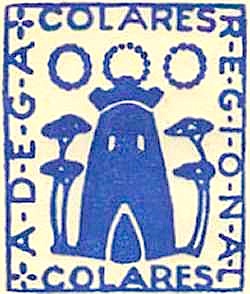 The deep
roots of the Ramisco grape almost literally reach
right back to the very establishment of Portugal as an
independent kingdom on the Iberian peninsula.
Noted in documents written more than five centuries
ago, the wines of Colares (pronounced ko-larsh)
have been long intertwined with Portugal’s royal
family, with some references dating to the 12th
century.
The deep
roots of the Ramisco grape almost literally reach
right back to the very establishment of Portugal as an
independent kingdom on the Iberian peninsula.
Noted in documents written more than five centuries
ago, the wines of Colares (pronounced ko-larsh)
have been long intertwined with Portugal’s royal
family, with some references dating to the 12th
century.
But before we delve into this
grape’s fascinating history, or try to describe the
remarkable wine made from this rare and noble variety,
or the reasons behind the appellation’s astonishing
heyday in the late 19th century on up to World War I,
or the curious story about its close connection to
Portugal’s earliest rulers in the 11th and 12th
centuries, let me first offer a bit of geographical
background.
Next, we should take a
small, but worthwhile detour into seeking out
Ramisco’s possible ampelographic origins;
Sand
Worshiper: The Ramisco grape
thrives in sandy soils, hence its rapid growth and
popularity across late 19th century Europe, when
the most of the continent’s vineyards were
devastated by the phylloxera pest, but not in
Colares, where the pest cannot abide sand.
It was then that Colares wines were known as the
“Bordeaux of Portugal,” owing to their finesse and
delicacy.
HOW
SAND SAVED THE WINES OF COLARES
Nestled
just behind a line of narrow sandy bluffs between the
Atlantic and the foothills of the Sierra Sintra
mountains, and located some 50 kilometers (30 miles)
northwest of Lisbon, Portugal, massive 50-to-100
year-old Ramisco grapevines snake amid apple orchards
planted nearby, which along with sturdy cane fencing,
shelter these earth-bound vines from ever-present
gusts of wind sweeping in from the ocean.
Without these fences, including some assembled from
stone boulders, gail-force blasts can literally rip
ripening Ramisco grapes right off the vines, says
Francisco Homem de Figueiredo, Winemaker, Adega Regional de Colares
(the Colares Regional Cooperative), and your
correspondent’s gracious and knowledgeable host during
my recent trip this past spring to a singularly
fascinating appellation.Welcome to Portugal’s tiniest,
oldest, and, today, a largely forgotten wine growing
region: Colares. It also holds another, less
auspicious vinous distinction. In 2012, Colares could
very well be the most-endangered wine appellation in
the world.
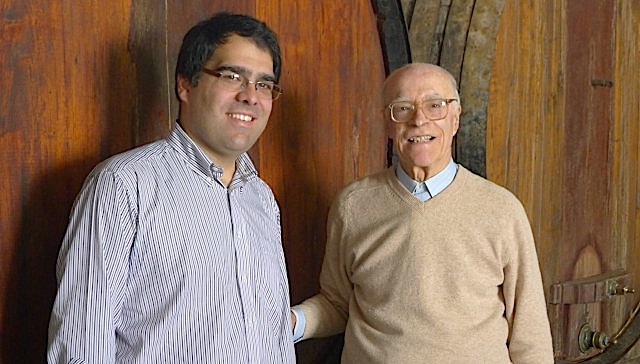 Colares Comrades: Francisco Homem de
Figueiredo, Winemaker, Adega do Colares, Colares,
Portugal, left, and Antonio Bernardino Paulo da
Silva, Owner, Colares Chitas, Azenhas do Mar,
Portugal, are the two most active producers of the
famed and long-lived red wines of the country’s
tiniest appellation. Photo: David
Lincoln Ross
Colares Comrades: Francisco Homem de
Figueiredo, Winemaker, Adega do Colares, Colares,
Portugal, left, and Antonio Bernardino Paulo da
Silva, Owner, Colares Chitas, Azenhas do Mar,
Portugal, are the two most active producers of the
famed and long-lived red wines of the country’s
tiniest appellation. Photo: David
Lincoln Ross
Hemmed
in by still expanding residential and commercial
developments, Colares’s once expansive rural landscape
of farms, orchards and seaside vineyards has gradually
given way to ultra-modern weekend retreats, luxury
hotels, and plush gated-communities. Adding to
the coastal transformation of these once sleepy
fishing ports and nearby hamlets, vineyard owners of a
certain age in Colares are “cutting back”, pun
intended: That is, these 60- and 70-year-olds are
selling their holdings, which nowadays are more
valuable as ocean-side residential lots than as
cherished backyard vineyards. (Indeed, Colares, and
neighboring Azenhas do Mar, have undergone a startling
evolution much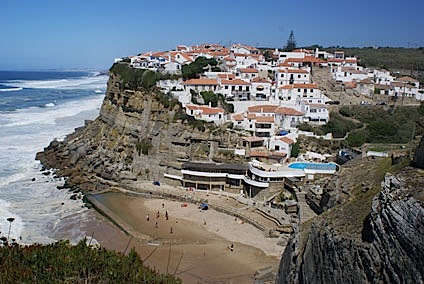 like the East End of New York’s Long
Island, where former potato fields have gradually
given way to more and more gaudy “McMansions” from
Westhampton to Montauk.
like the East End of New York’s Long
Island, where former potato fields have gradually
given way to more and more gaudy “McMansions” from
Westhampton to Montauk.
With some owners literally as old
as the vines they have lovingly tended and grown up
with, such sales to aggressive developers further
accelerate the appellation’s diminishing acreage,
according to Figueiredo. During our tour of some
of these family-owned holdings, whose dwindling group
of 55 owners sell their grapes directly to the
Colares Wine Cooperative, Francesco estimated that
compared to a century ago when Colares vineyards
attained almost 1,000 hectares (2,500 acres), today
the shrinking appellation –which was formally
established in 1908 — totals a mere 19 hectares,
barely 50 acres! (In addition to Ramisco wines, there
are 15,000 bottles of white Malvasia wine produced
annually in the Colares appellation, according
to Figueiredo.)
But, owing to the appellation’s
sandy soil that makes it uninhabitable to the
phylloxera pest, Colares wines in the late 19th
century emerged as the toast of enophiles and
epicures across Europe. This turn of events came
about not only because of the wine’s unique
availability — recall, most of the rest of Europe’s
vineyards had been nearly completely destroyed by the
phylloxera pest — but also because the wines of
Colares were, and remain today, delicious, refined and
eminently age-worthy.
 For all these reasons, Colares wines
became known as the “Bordeaux of Portugal.” Although
as we shall see, in fact, Colares wines more likely
bring forth associations with France’s other equally
renowned red wine appellation, Burgundy. Indeed, the
great 19th century Portuguese novelist Jose Maria de
Eça de Queiroz, said of Colares: “Os vinhos
mais franceses de Portugal!”, “the most French wines
of Portugal.” (This quotation is taken from an
excellent account about Colares wines by Wiremu
Andrews, a noted New Zealand-born sommelier.
For all these reasons, Colares wines
became known as the “Bordeaux of Portugal.” Although
as we shall see, in fact, Colares wines more likely
bring forth associations with France’s other equally
renowned red wine appellation, Burgundy. Indeed, the
great 19th century Portuguese novelist Jose Maria de
Eça de Queiroz, said of Colares: “Os vinhos
mais franceses de Portugal!”, “the most French wines
of Portugal.” (This quotation is taken from an
excellent account about Colares wines by Wiremu
Andrews, a noted New Zealand-born sommelier.
SO
WHAT DOES A COLARES TASTE LIKE?
Along with Colares’s sole remaining
private bottler, Antonio Bernardino Paulo da Silva, of
Azenhas do Mar, Portugal, who, at the age 84, still
comes to the da Silva winery every day, overseeing his
company top brand, Colares Chitas, Francisco
soldiers on. All told, between Figueiredo’s Colares
cooperative and da Silva’s Chitas sales, only
50,000 bottles of Colares are produced annually.
As we tasted a number of
Francesco’s Arenae vintaged-dated Ramisco wines at the
Adega, I asked Francisco what wines most people
might be familiar with most nearly resemble a classic
Colares wine?
Very Cherry: The Arenae Colares, vintage 2005, from the Adega Regional
do Colares, is a medium-bodied 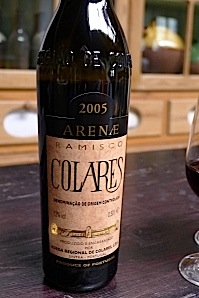 red wine packed with fresh-picked
red berry aromas and black cherry and
flavors.
Photograph: David Lincoln Ross
red wine packed with fresh-picked
red berry aromas and black cherry and
flavors.
Photograph: David Lincoln Ross
Francicsco offered the most
remarkable, and enlightening, reply: a Pinot Noir
Burgundy from a Premier Cru Cotes de Nuits, or
a fine Nebbiolo bottling from Barolo in Italy. In
fact, if you poll sommeliers as well as expert
Portuguese and Spanish wine importers, they might well
tell you a Colares wine exhibits the following
characteristics: Ramisco-based wines are
light-to-medium bodied; they feature distinct, some
say relatively high, levels of acidity; and thanks to
the Ramisco’s thick skin, Colares wines also possess
ample levels of tannin; and most would note their
alcohol level rarely exceeds 12% or 12.5%. At their
best, these wines are enormously long-lived,
well-structured, balanced and display great finesse,
all capped by a long, lingering finish of red berry
fruit and black cherry jam. In their youth, they can
be a bit astringent, but with age, they blossom!
These same sommeliers and importers
will also tell you that Colares wines, even if they
are known to the taster (and most likely you’ll
receive a blank stare from even the most dedicated
wine geek on hearing the appellation or the name of
the grape, that is how obscure this appellation and
its wines are), they will be variously described as
“light”, or perhaps “out of fashion”, and most
assuredly, “not big, forward or powerful enough” to
suit the palates of most of today’s wine drinkers,
aficionados who truly favor far more robust bottlings
of New World Cabernet Sauvignons, Merlots,
Bordeaux blends, Zinfandels or Rhone-style Syrah,
Mourvedre and Grenache blends.
DOES
THE RAMISCO HAVE BURGUNDIAN ROOTS? – A VINOUS
MYSTERY
In
fact, notwithstanding Colares’s reputation as the
“Bordeaux of Portugal”, Francisco’s taste association,
coupling Pinot Noir and Ramisco, actually carries some
strong historical/circumstantial weight. And it’s all
in keeping with a central theme of the establishment
of Portugal as an independent nation, free from the
orbit of Castile and León, in the 12th century,
then one of the most powerful ruling clans of the
Iberian peninsula. Here is a quick historical sketch
that offers some suggestive context to the possible
Burgundian connection for the Colares wine
appellation. It’s a little involved, but a good tale!
As the Moors were gradually eased
out of the Iberian peninsula by Christian
crusaders during the so-called Reconquista, or
Reconquest, from the 8th to 12 centuries,
inter-marriage among leading Catholic noble families
occurred frequently. While much of present-day
Portugal during this period up to the 11th century was
increasingly controlled by Castile’s ruling family,
ultimately a related branch of the Castilian clan
ultimately broke off in a series of battles; their aim
was to achieve complete Portuguese sovereignty.
Following a successful final battle against the
Castilian overlords, Portugal’s first monarch was
recognized by the ultimate religious and dynastic
referee back then, the Pope in Rome.
 The
new realm’s first king (left) was christened Afonso Henriques I
(1109-1185), who is also known as o Fundador,
as in “the Founder” of Portugal. The Moors, who
Afonso I (below)
pursued ruthlessly and without mercy during his long
reign, called him ibn-Arrik in Arabic, which
translates to “son of Henry.” Now stay with me here!
Just a little more history!
The
new realm’s first king (left) was christened Afonso Henriques I
(1109-1185), who is also known as o Fundador,
as in “the Founder” of Portugal. The Moors, who
Afonso I (below)
pursued ruthlessly and without mercy during his long
reign, called him ibn-Arrik in Arabic, which
translates to “son of Henry.” Now stay with me here!
Just a little more history!
Who was Afonso Henriques I’s
father? Henry of Burgundy; in Portuguese and Spanish
history books, he is known as Conde Henrique,
or Count Henry of Portugal. How did a Burgundian come
to be a Count of Portugal? Well, in 1093, Henry had
married Theresa, who was the illegitimate daughter of
Alfonso VI of Castile and Leon. For Theresa’s dowry,
Alfonso VI conveyed the “County of Portugal”, then a
fief, or possession, of the House of Castile to Henry.
So, it is speculated that Count Henry, along a number
of other Burgundian knights and their servants who all
came into Iberian territory determined to push out the
Moors once and for all, might also have brought vine
cuttings from home. This was not unprecedented; Roman
consuls and their retinues, a thousand years earlier,
brought indigenous grape cuttings from Italy, and  elsewhere, to
plant in the far outposts of the Roman empire.
elsewhere, to
plant in the far outposts of the Roman empire.
So, as some
wine historians posit, it is quite possible that the
Ramisco grape could be — and, by looks alone, it does
unerringly resemble the Pinot Noir grape in shape,
size and color — a long lost “cousin” of this renowned
French noble grape. Most important, Portugal’s
first king, Afonso Henrique I, who was the son of
Count Henry and Theresa, and Afonso’s royal
descendents, can certainly trace an important part of
their genealogical roots back to Burgundy. Who
knows then, perhaps Ramisco’s ampelographic
roots go back to this time as well? But whatever
the source of the Ramisco grape, Afonso III, the
grandson of o Fundador, did much to
commercialize, regulate, tax and demarcate the wine
growing regions in and around Sintra, where the royal
family summered to avoid the awful heat of Lisbon, as
well as the seaside vineyards of Colares, which
are only six miles from Sintra.
By the 15th and 16th centuries,
there is abundant documentation showing that the wines
of Colares were not only gracing the royal tables in
both Sintra and Lisbon, but were also being busily
exported around the world, including to Portugal’s
many Brazilian and Indian colonial outposts in the New
World and the Far East.
Now, to bring us back to the
all-important present, whether with a grilled steak or
smoky pork ribs, some succulent lamb chops or a hearty
stew, fresh, pan-seared trout or slow-roasted sword
fish or sea bass, try a Colares wine and you won’t be
disappointed!
To
locate and sample the Colares wines in the U.S.,
visit: bit.ly/Re7xWJ
David Lincoln Ross is a food, wine and travel writer based in NYC. For more blogposts, please visit: davidlincolnross.wordpress.com
❖❖❖
 LEONARD
BERNSTEIN'S ALREADY WRITING
LEONARD
BERNSTEIN'S ALREADY WRITING THE MUSIC FOR THE SHOW--"ON THE TOWN IN LJUBLJHANA"
“I had one day to see Slovenia. Ten
hours, to be exact. Eight, if you count the driving
time from Trieste, Italy—the port where my cruise ship
was stopping—to Slovenia’s capital, Ljubljana, and
back. I had to make the most of this one day. . . . I
had never been to Slovenia, had always wanted to visit
it, and might never get back. And we had to return to
Trieste by 7 p.m., before our ship set sail for the
next port of call.”—Wendy Perrin, “Slovenia,” Conde Nast Traveler
(3/12).
WRETCHED EXCESS, LAS
VEGAS and NYC DIVISIONS
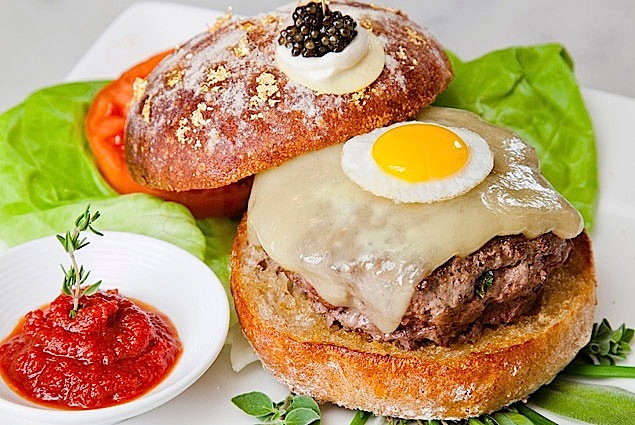 . . . Meanwhile in NYC,
the Guinness Book of
World Records declared The
Le Burger
Extravagant, sold at New York's Serendipity 3 for
$295 the world's most expensive burger (left),
containing Japanese Waygu beef, 10-herb white truffle
butter, smoked Pacific sea salt, 18-month cheddar,
shaved black truffles, a quail egg, and a white
truffle-buttered roll, all held together by a solid gold,
diamond-encrusted toothpick holding the whole
thing together.
. . . Meanwhile in NYC,
the Guinness Book of
World Records declared The
Le Burger
Extravagant, sold at New York's Serendipity 3 for
$295 the world's most expensive burger (left),
containing Japanese Waygu beef, 10-herb white truffle
butter, smoked Pacific sea salt, 18-month cheddar,
shaved black truffles, a quail egg, and a white
truffle-buttered roll, all held together by a solid gold,
diamond-encrusted toothpick holding the whole
thing together.
❖❖❖
Any of John Mariani's
books below may be ordered from amazon.com.
 |
My latest book, which just won the prize for best book from International Gourmand, written with Jim Heimann and Steven Heller, Menu Design in America, 1850-1985 (Taschen Books), has just appeared, with nearly 1,000 beautiful, historic, hilarious, sometimes shocking menus dating back to before the Civil War and going through the Gilded Age, the Jazz Age, the Depression, the nightclub era of the 1930s and 1940s, the Space Age era, and the age when menus were a form of advertising in innovative explosions of color and modern design. The book is a chronicle of changing tastes and mores and says as much about America as about its food and drink.
“Luxuriating vicariously in the pleasures of this book. . . you can’t help but become hungry. . .for the food of course, but also for something more: the bygone days of our country’s splendidly rich and complex past. Epicureans of both good food and artful design will do well to make it their coffee table’s main course.”—Chip Kidd, Wall Street Journal.
“[The menus] reflect the amazing craftsmanship that many restaurants applied to their bills of fare, and suggest that today’s restaurateurs could learn a lot from their predecessors.”—Rebecca Marx, The Village Voice. |
"Eating Italian will never be the same after reading John Mariani's entertaining and savory gastronomical history of the cuisine of Italy and how it won over appetites worldwide. . . . This book is such a tasteful narrative that it will literally make you hungry for Italian food and arouse your appetite for gastronomical history."--Don Oldenburg, USA Today. "Italian
restaurants--some good, some glitzy--far
outnumber their French rivals. Many of
these establishments are zestfully described
in How Italian Food Conquered the World, an
entertaining and fact-filled chronicle by
food-and-wine correspondent John F.
Mariani."--Aram Bakshian Jr., Wall Street
Journal.
"Equal parts
history, sociology, gastronomy, and just
plain fun, How Italian Food Conquered the
World tells the captivating and delicious
story of the (let's face it) everybody's
favorite cuisine with clarity, verve and
more than one surprise."--Colman Andrews,
editorial director of The Daily
Meal.com. "A fantastic and fascinating
read, covering everything from the influence
of Venice's spice trade to the impact of
Italian immigrants in America and the
evolution of alta cucina. This book will
serve as a terrific resource to anyone
interested in the real story of Italian
food."--Mary Ann Esposito, host of PBS-TV's
Ciao
Italia. "John Mariani has written the
definitive history of how Italians won their
way into our hearts, minds, and
stomachs. It's a story of pleasure over
pomp and taste over technique."--Danny Meyer,
owner of NYC restaurants Union Square Cafe,
Gotham Bar & Grill, The Modern, and
Maialino.
|
 |
 |
 |
 |
 |
 |
 |
 |
 Everett Potter's Travel Report:
Everett Potter's Travel Report: 
 Eating Las Vegas
is the new on-line site for Virtual Gourmet
contributor John A. Curtas., who since 1995
has been commenting on the Las Vegas food
scene and reviewing restaurants for Nevada
Public Radio. He is also the
restaurant critic for KLAS TV, Channel 8 in
Las Vegas, and his past reviews can be
accessed at KNPR.org.
Click on the logo below to go directly to
his site.
Eating Las Vegas
is the new on-line site for Virtual Gourmet
contributor John A. Curtas., who since 1995
has been commenting on the Las Vegas food
scene and reviewing restaurants for Nevada
Public Radio. He is also the
restaurant critic for KLAS TV, Channel 8 in
Las Vegas, and his past reviews can be
accessed at KNPR.org.
Click on the logo below to go directly to
his site.

Tennis Resorts Online: A Critical Guide to the World's Best Tennis Resorts and Tennis Camps, published by ROGER COX, who has spent more than two decades writing about tennis travel, including a 17-year stretch for Tennis magazine. He has also written for Arthur Frommer's Budget Travel, New York Magazine, Travel & Leisure, Esquire, Money, USTA Magazine, Men's Journal, and The Robb Report. He has authored two books-The World's Best Tennis Vacations (Stephen Greene Press/Viking Penguin, 1990) and The Best Places to Stay in the Rockies (Houghton Mifflin, 1992 & 1994), and the Melbourne (Australia) chapter to the Wall Street Journal Business Guide to Cities of the Pacific Rim (Fodor's Travel Guides, 1991).


MARIANI'S VIRTUAL GOURMET
NEWSLETTER is published weekly. Editor/Publisher: John
Mariani.
Contributing Writers: Christopher Mariani, Robert Mariani,
John A. Curtas, Edward Brivio, Mort Hochstein,
Suzanne Wright, and Brian Freedman. Contributing
Photographers: Galina Stepanoff-Dargery,
Bobby Pirillo. Technical Advisor: Gerry McLoughlin.
© copyright John Mariani 2012
